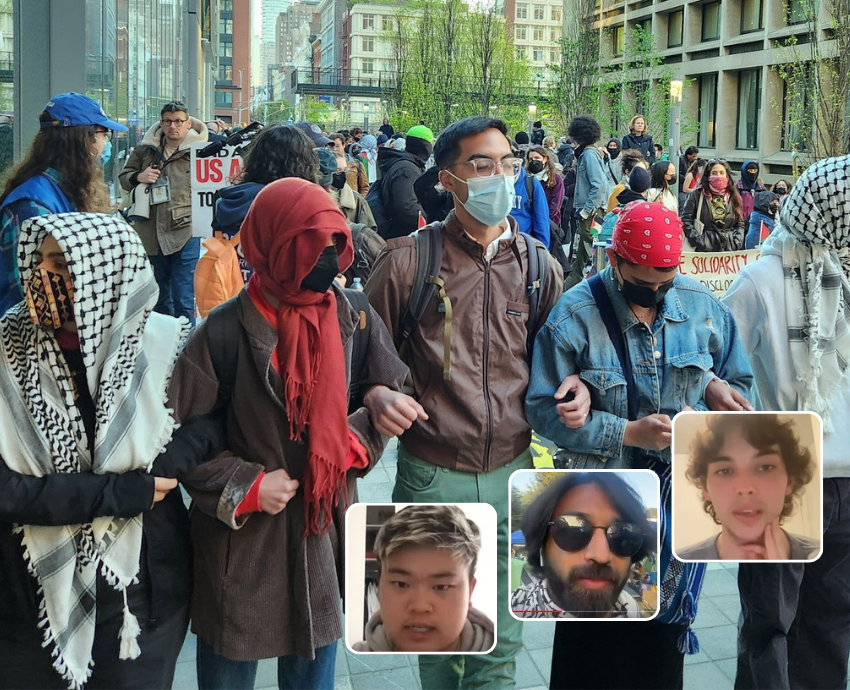
Students at more than 150 universities around the world have set up Gaza solidarity encampments to demand their institutions cut ties with apartheid Israel and weapons companies supporting the genocide in Gaza. At the time of writing, 12 Australian campuses are participating.
One of the first encampments set up in the United States was at Columbia University in New York City. When the university administration called in the police, who arrested more than 100 students amid a brutal crackdown, encampments quickly spread across the country and internationally.
Following the violent police crackdown on encampments at Columbia and City College, Green Left’s Isaac Nellist, Jacob Andrewartha and Chloe DS spoke to three US student activists about the protests: Cyn Huang from the University of California (UC), Berkeley, Daniil Sapunkov from the City University of New York’s Hunter College and Amey from San Francisco State University (SFSU). All have helped build solidarity encampments on their campuses and Cyn and Daniil are members of the Young Democratic Socialists of America (YDSA).
GL started by asking them how their campus protests started.
Cyn, who is a trade unionist and former union organiser for the United Auto Workers (UAW) Local 4811 (which represents university workers on UC), said he was attending the Labor Notes conference in Chicago “when the camps first went up and it became clear that the movement was going to explode”.
“We were talking to so many people who were excited by what they were seeing … there was this nervous anticipation of ‘I really support this but I don’t know if I can do it on my campus’.” Cyn said he and other activists encouraged them to “talk to five of your friends, get some tents together, empower everyone to go talk to five more of their friends and you can really get something started”.
405 - 11 cr YDSA.png
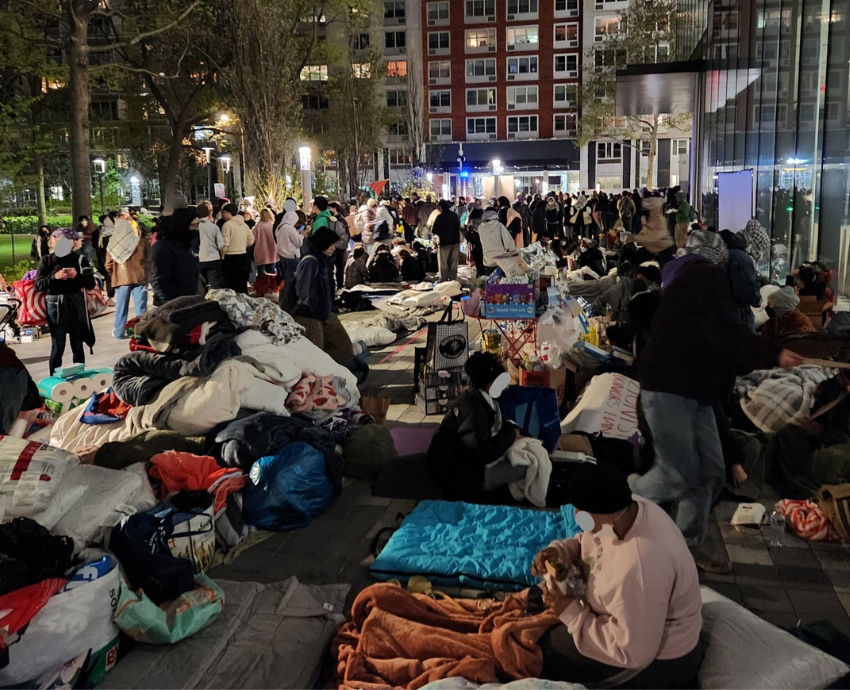
Getting started
Cyn said a lesson activists learned early on was to take the initiative and not to wait for the formal institutions on their campus to get the encampments going. “A lot of the existing institutions are more established, they have more resources and more to lose, but a scrappy group of young people who are really inspired to throw themselves in the movement, they can get a couple of friends together, get a couple of tents together and then we can figure out the legal support, the media, etc.
“For a lot of the camps that came after the first few days, it had this very makeshift, impromptu character.”
Daniil, a history student and YDSA student organiser, said that the images of police brutality at Columbia University against peaceful protesters, including images of students “being crushed and beaten and tear gassed by the NYPD” ... initially drove people “to go to Columbia, be outside the gates [and] join the protest”.
He said: “In many ways, it saved the encampment and made it go as long as it did because of the numbers on the outside.
“But at some point [we] realised that we have got to go back to our own campuses and begin setting up tents of our own.”
Amey is a media arts student who has been trying to mobilise the South Asian committee on campus around issues such as solidarity with Palestine. He explained that things developed a little differently at San Francisco State due to a couple of factors that make the campus unique.
“For one, we are the last campus on American soil that still has a student organisation that represents the Palestinian student body, known as the General Union of Palestinian Students (GUPS). There are GUPS chapters all over the world.
“The second thing ... is that our campus is primarily commuter and working class and also is ethnically one of the most diverse campuses in California as well as the entire country.”
Amey said these factors affected how they organised, especially after seeing the widespread police violence and the Zionist attacks at the University of California, Los Angeles (UCLA).
“[T]rying to be prepared for that was a large part of planning our encampment,” he said.
The students formed committees to address things they saw happening on other campuses that led to violence or to media narratives that the encampments were only about university/campus issues.
“[W]e wanted to centre Palestinians in Gaza instead of us. It’s not about us. So there was a lot of outreach. Reaching out to a lot of organisations like Food Not Bombs to provide food and water. We also were very fortunate to have had widespread faculty [academic staff] support.”
“There are a lot more teach-ins, especially directly involving members of the General Union of Palestinian Students.
“We haven’t really faced a lot of violence at all or any sort of co-opting or any nasty things that a lot of these college campuses are facing. I think we’ve been very fortunate in that regard but ... that could change any second.”
405 - 12 cr YDSA.png
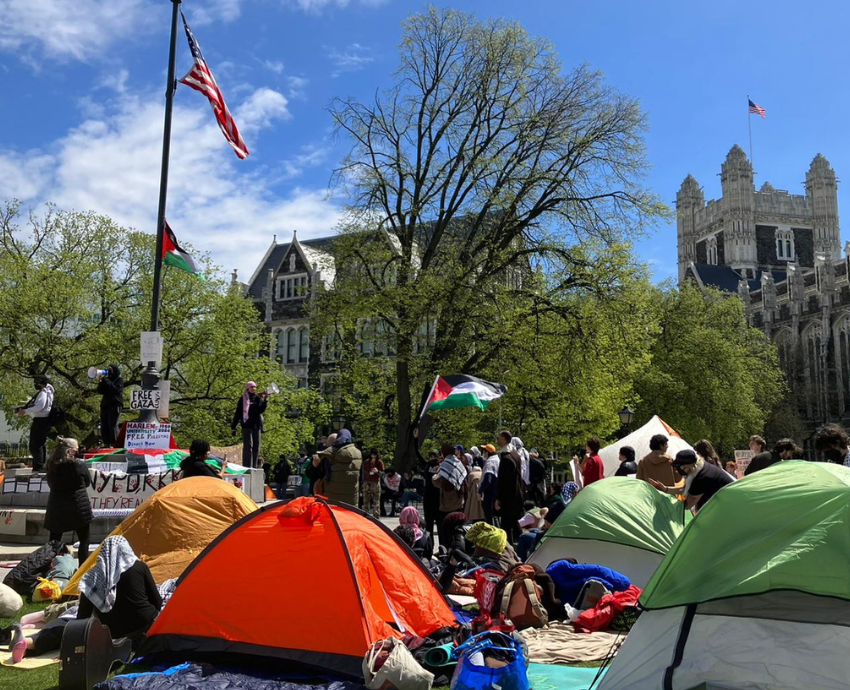
Politicisation
The encampments are providing political spaces for teach-ins and other politicising activities.
“Different camps have different cultures,” Cyn said. “The culture is contingent on things like who is in the political leadership [and] what the organisational ecosystem of your campus looks like.
“If there’s a built out ecosystem, especially with established groups based around Palestinian identity ... then most students and participants will probably look to those groups for leadership.
“Whereas other campuses had to build this occupation from scratch [so] there’s a lot of opportunity I think to set a new political and organisational tone.
“I would say there’s a very rapid and deep politicisation. This movement to me feels qualitatively different from everything that I’ve experienced before. I wasn’t around for 2010’s student activism but it seems like the movement is much more mature due to the broader political context in which it exists.
“I was politicised by Bernie [Sanders’ campaign]. A lot of other people are Starbucks workers getting shopfloor organising experience, doing labour solidarity work these past few years and have build relationships with faculty campus unions, have participated in other issue based groups and social struggles like Black Lives Matter.
“Compared to Occupy, this movement actually has clear communicable demands. Almost every campus has four to five BDS [Boycott Divestment and Sanctions] related demands...
“We are using militant direct action tactics and there are fewer examples of ultra-left acts of desperation, although I anticipate that might be more so the case if there’s a lack of democracy in the movement...
“A lot of people, myself included, have had some experience with labour in one form or another. There’s an instinct to reforge relationships with labour and acknowledgment that students alone can’t really carry this movement to its logical conclusion — that we need to catalyse action and support and build relationships with other sectors of campus and society.
“We are still very much at the beginning of the reformulation of the student movement, given certain growing pains we’ve seen around various themes — like the balance to strike between democracy and security culture, national coordination, sometimes cynical misuses of identity politics and just basic questions of method.
“[For example] very few people in the student movement have experiences doing occupations [or] running effective mass meetings...
405 - 14 cr YDSA on X.png
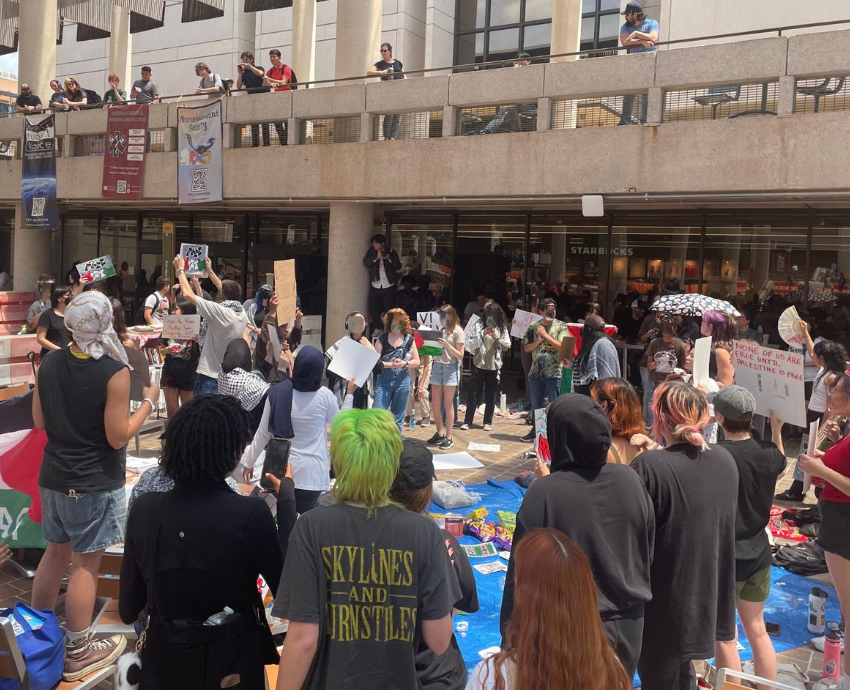
Mass action
“I think this is a new context in which the socialist left is really throwing itself into a broader context and learning how to do mass politics, whereas before we’ve kind of been a little abstentionist about things, because people have critiques about the certain liberal, NGO culture of other organisations.
“I think these critiques are very well taken but the way to change this culture and improve them is not to isolate ourselves but to get involved and win people to our perspectives about mass action.
“The long-term lessons and the way people will be politicised, I think it’s too early to determine that right now. [There is] the question of democracy in those movements, if there are going to be mass meetings, if people can synthesise perspectives and formulate next steps. It’s not a really developed culture right now, so if the movement drags on, if there are disagreements about what to do next we can see a lot more disunity. In that case people can be politicised in very different directions.”
Daniil said this movement “is something I have ever personally experienced or seen in my life or maybe even saw coming”. Nevertheless, the encampments build on “a rich history of student movement and student organising”, especially at CUNY.
CUNY’s administration even embraces this imagery in its promotion of the campus as historically a space for student movements and radical change, he said, including campaigns by students in the late 1960s to establish a dedicated school of African and Puerto Rican studies at City College, through militant direct student action.
“And now ... instead of embracing or listening to students demands, CUNY have retaliated in a very violent way last night.
“The encampment in CUNY lasted for about a week, I think largely due to the fact that that we’ve been on Spring Break and today is the first day back to school. And so the night prior, the NYPD swept the camp in its entirety, in a very violent, very oppressive manner.”
Daniil said it “felt very surreal” to be seeing SWAT teams breaking into the building at Columbia “filled with peaceful protesting students”, then to look up from the phone “to see a group of police officers storming towards me because I’m standing outside of City College”.
Daniil said the City College encampments “drew faculty and student leadership from different parts of the city. It was a collection of people from different backgrounds, organisational experiences, levels of political development, and age”.
Initially, the leaders were unknown to people and to get involved in an encampment, people would be vetted on group chats and had to wait to be told what to do. Daniil said this reflected “debates around security versus democratisation” of the protests.
Amey explained that SFSU has “somewhat of a history of student organising” that the administration likes to fall back on.
“[T]he campus is really famous for the longest and largest strike in US history, which was in 1968, during the Civil Rights Movement.” However, “students here feel disconnected with the administration” and its “position on Palestinian liberation”.
405 - 13 cr YDSA.png
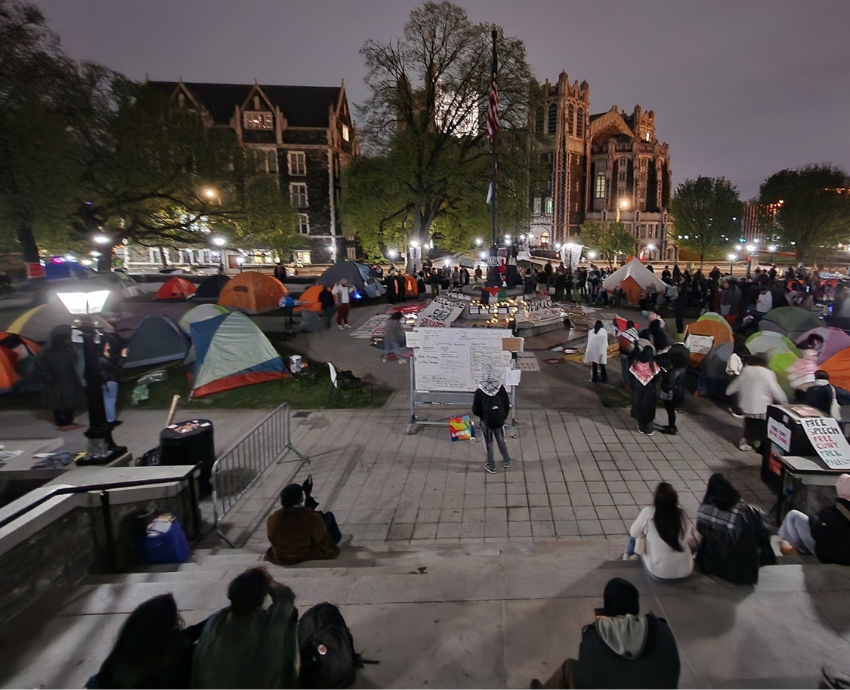
Educate, agitate, organise
Amey explained that every campus has very specific demands. At SFSU, students want the university to disclose which companies, complicit in the genocide in Gaza, it spends tuition dollars on.
“We want the California State University (CSU) system as a whole — which our campus is a part of — to divest from the companies that we know [are] complicit in the genocide in Gaza.
“We want the administration of this campus to defend Palestine, its Palestinian student body and to reject and oppose Senate bills ... such as Senate Bill 1287, which curbs students rights to protest around Palestine and to declare what’s happening [as] genocide and an ethnic cleansing.
“Every campus’s relationship to the military and to the weapons manufacturing companies that are complicit in the genocide in Gaza are different.”
Amey believes that leftist and socialist perspectives on community organising have been essential to the protest camps.
“We have folks from organisations such as Party for Socialism and Liberation as well as Palestinian orgs or the Palestinian youth movement that are helping us make this a reality. A striking amount of folks who are involved with the organising of all this, are members of YDSA here.
“Working with each other and learning from each other was a very key factor in doing all this.
“[W]e have ... a media committee, a security committee, a resources committee, a medics committee and an activities committee.
Activities such as teach-ins and mural celebrations, like one for Edward Said which was being held during the interview, “are primarily to include and to learn from members of the Palestinian Student body”.
Amey explained that the medic committee is there for anyone who gets hurt or needs medicine. The media committee designates people to talk to the media, take pictures or work on social media posts to show what’s happening or “to encourage people to join in by telling them how much of their tuition money goes to genocide in Gaza”.
This includes “telling them how much money the CSU system spends on these high risk securities — which are basically just stocks and bonds — in companies like Boeing and Lockheed Martin, which are complicit in the genocide”.
The security committee “is for legal stuff and cops. And also unfriendly people or people that are causing problems that aren’t necessarily related to Zionism. Just keeping an eye out for each other, keeping each other safe ... as well as [providing] a strong legal backing.
“We contacted the national lawyers guild here in California so that if anything happens they have our back. We have a jail support plan if we face ... arrests or police violence. We have legal observers who will essentially record what the cops do.”
The resources committee is basically about reaching out for food, water and other supplies for the camp. “Faculty members sometimes provide stuff too or just community members, students [and] alumni,” he said. “[I]f we are missing anything, sending folks on runs to go get it, or contacting others organisations to help us source those things.”
Amey said the SFSU encampment is operating in a more or less democratic way. “We had a vote today, for example, to democratically elect leaders to decide with the community, what this movement will look like going forward, potentially even after the genocide, which I hope ends soon.
“Those leaders will lead alongside members of the Palestinian student body, members of GUPS, we are all on the same level, one does not have precedence over the other. We want to centre Palestinian students as much as we can, but also we don’t want to give them the brunt of the work or make them take the fall or anything. We do want to protect them as much as we can because they are the most vulnerable folks on this campus if the cops come, if the administration comes down hard on us.”
405 - 15 cr YDSA.png
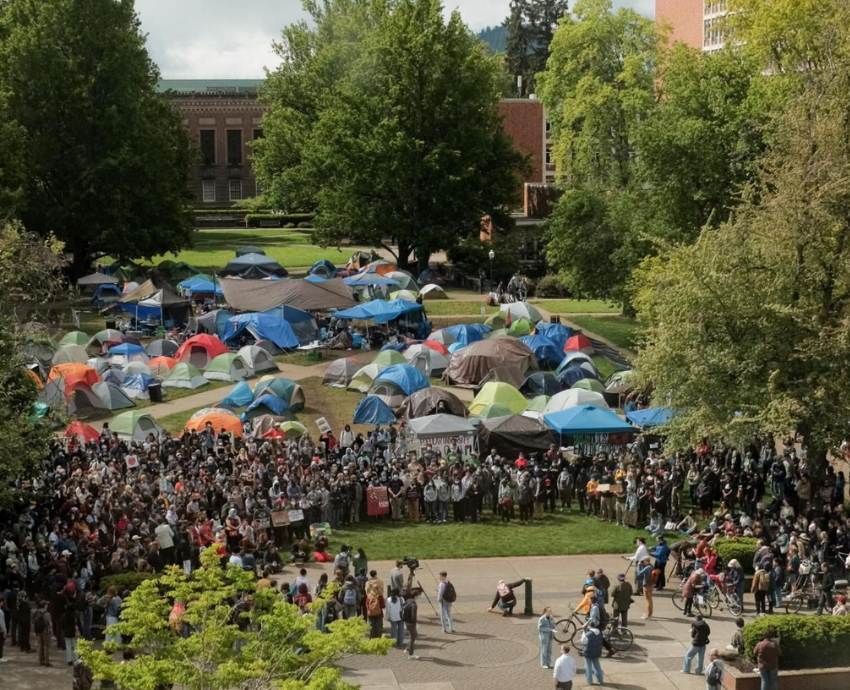
[Watch the full interview here.]